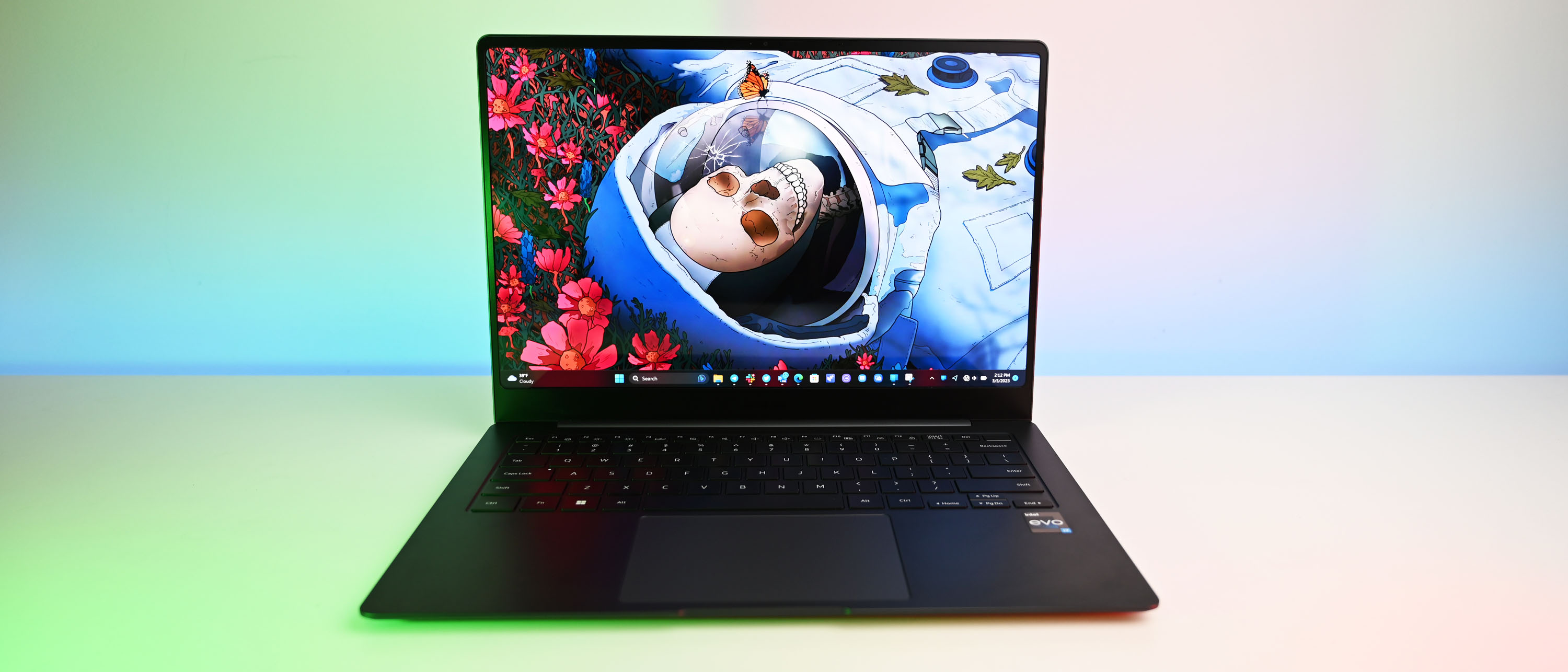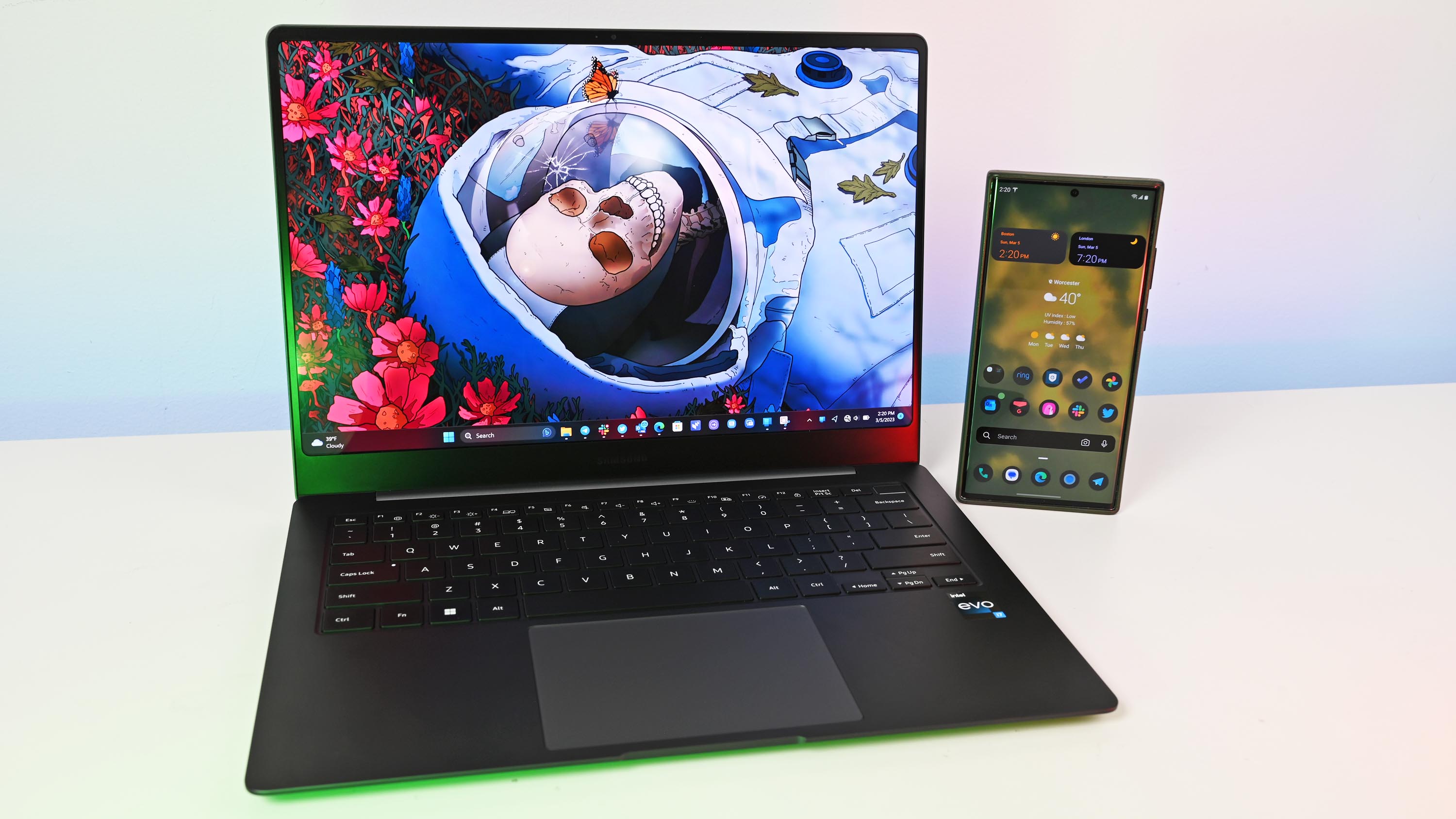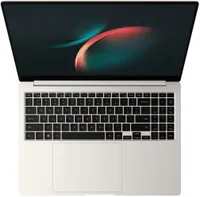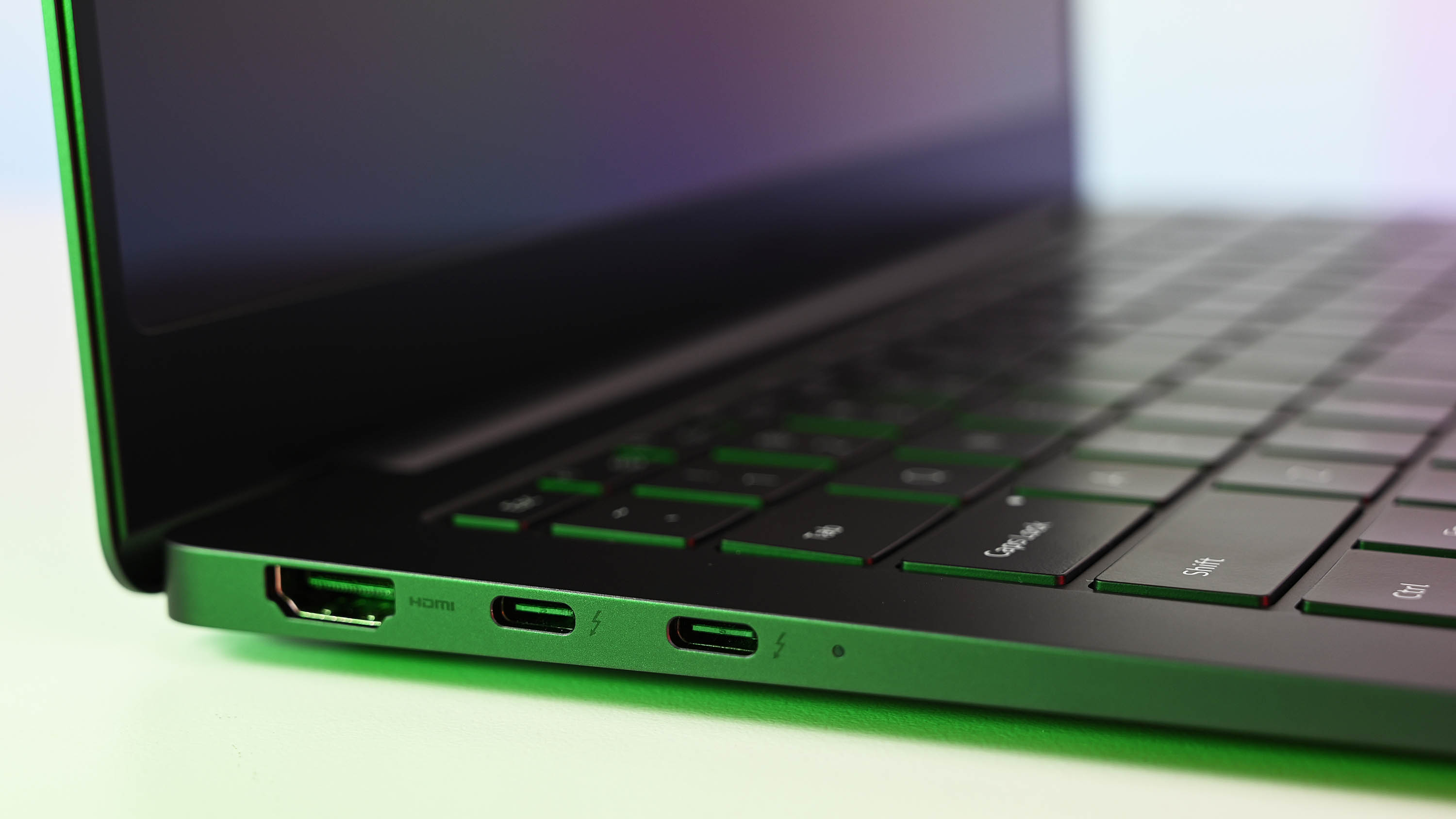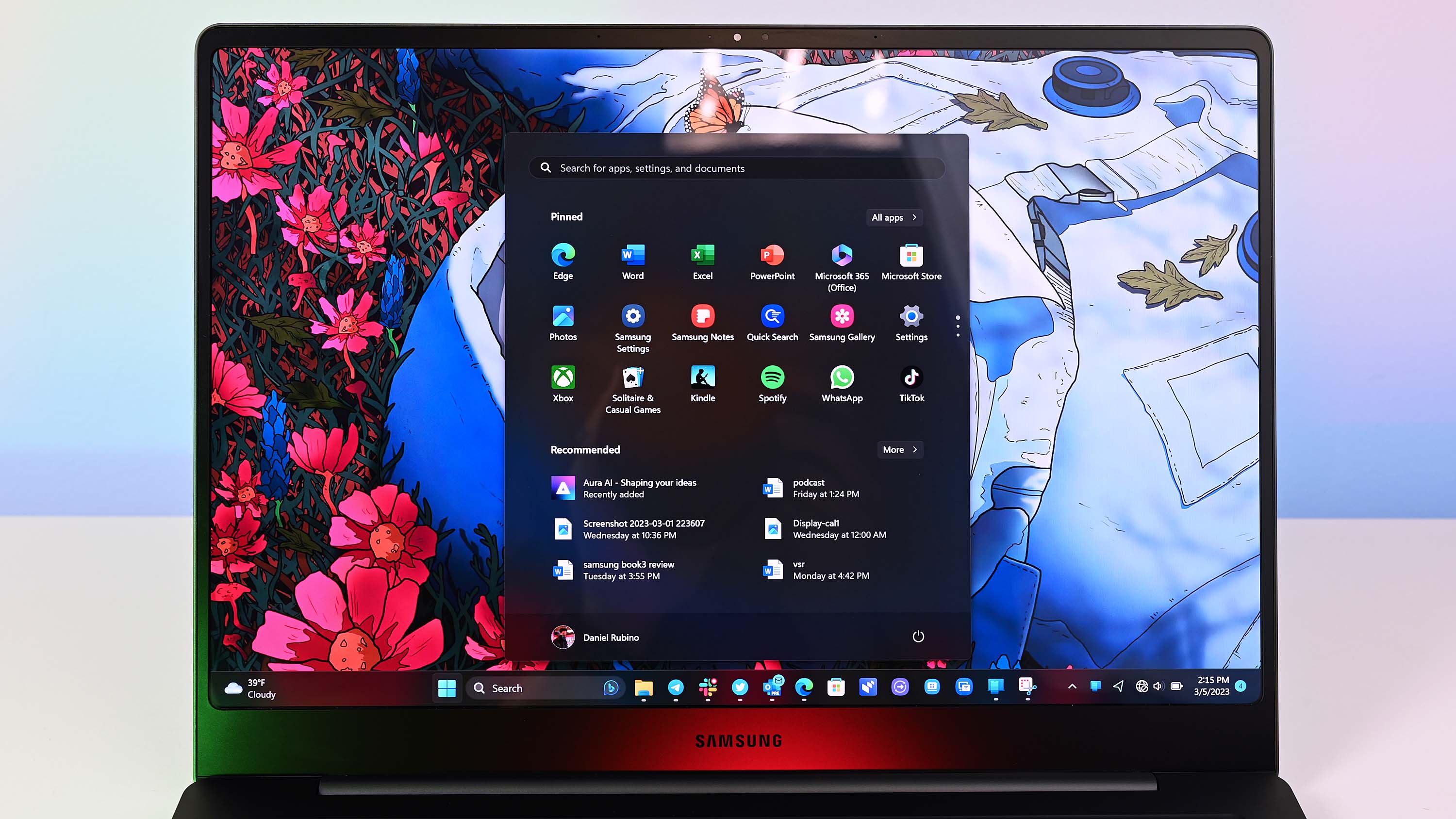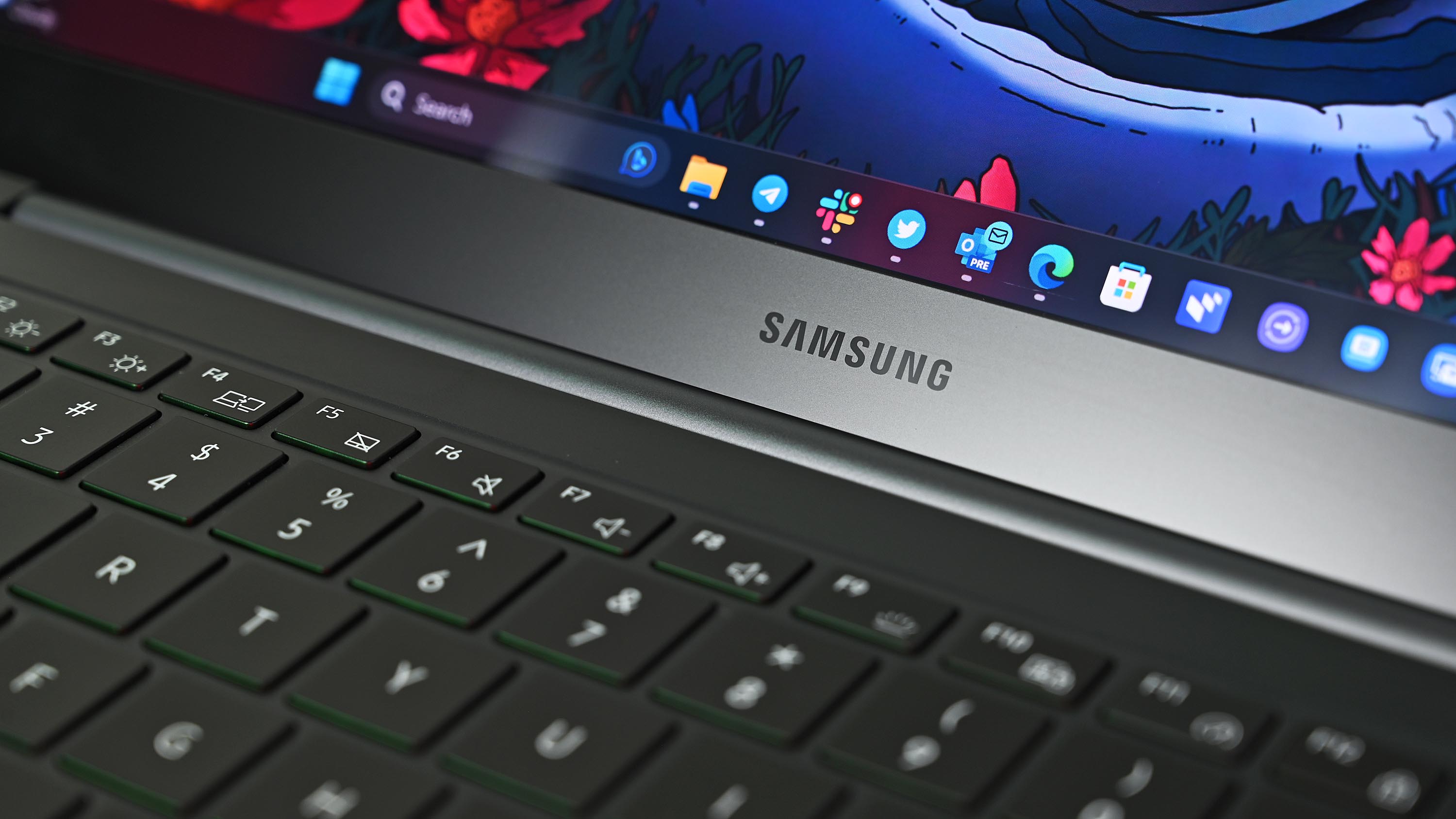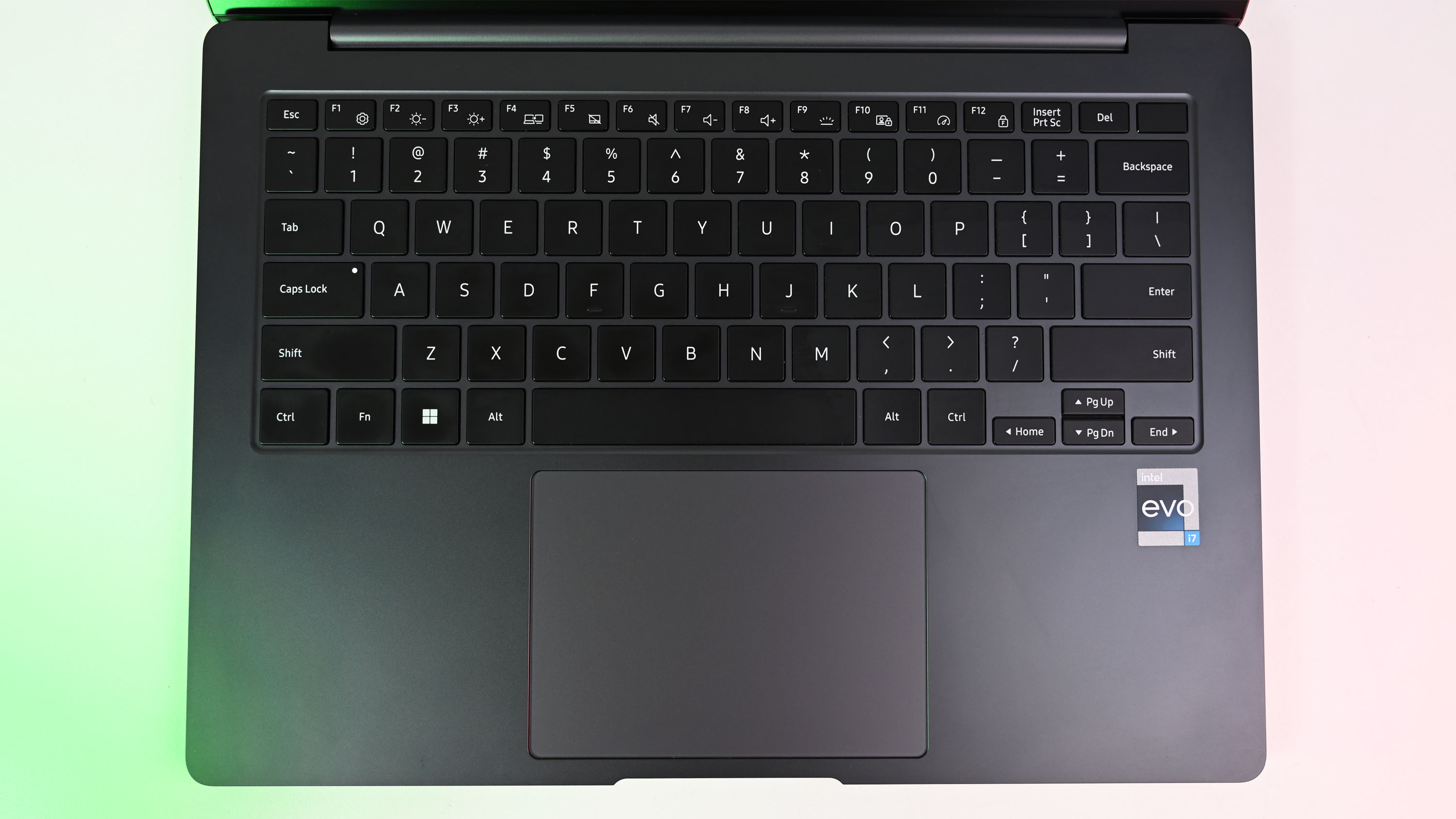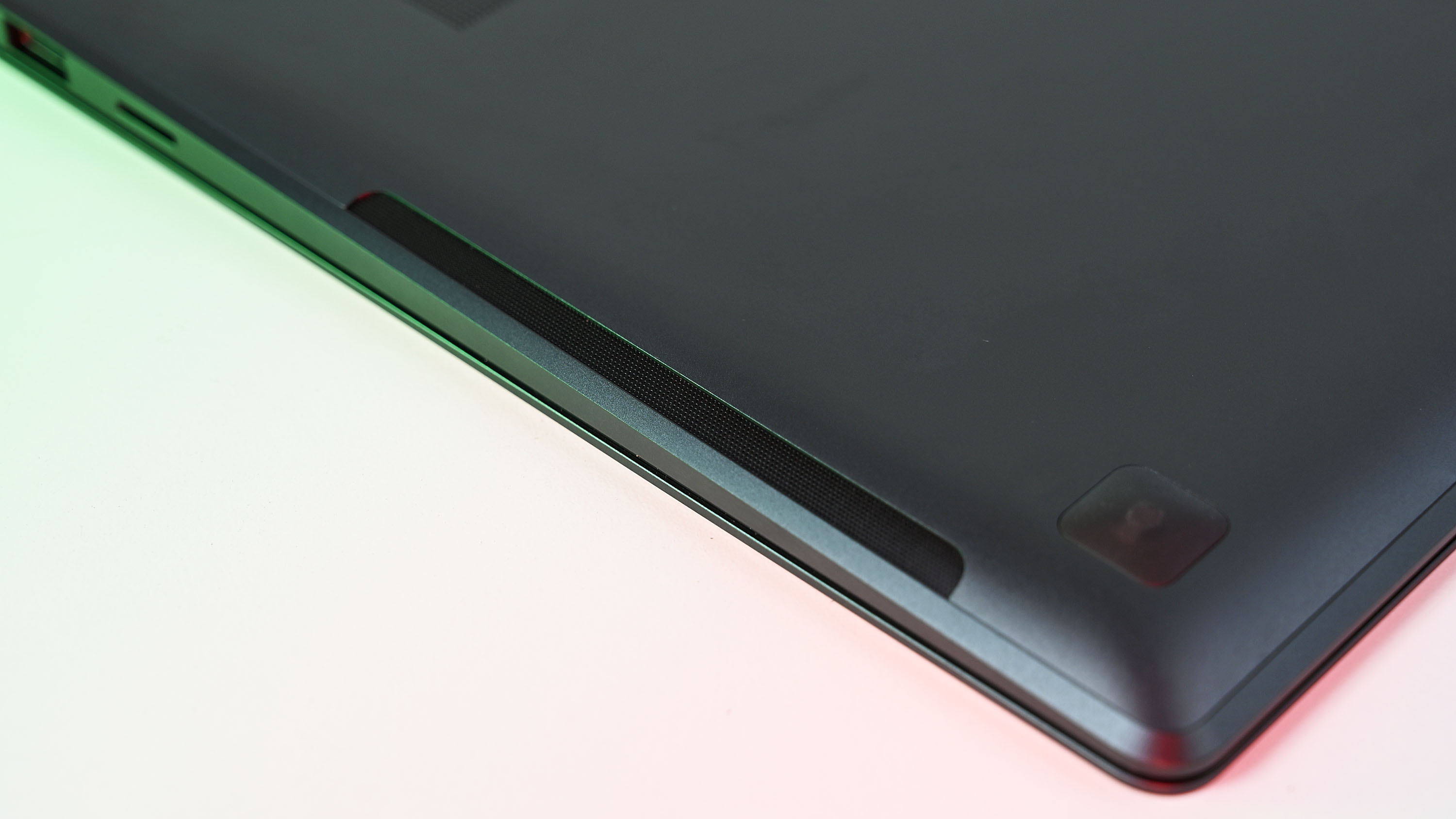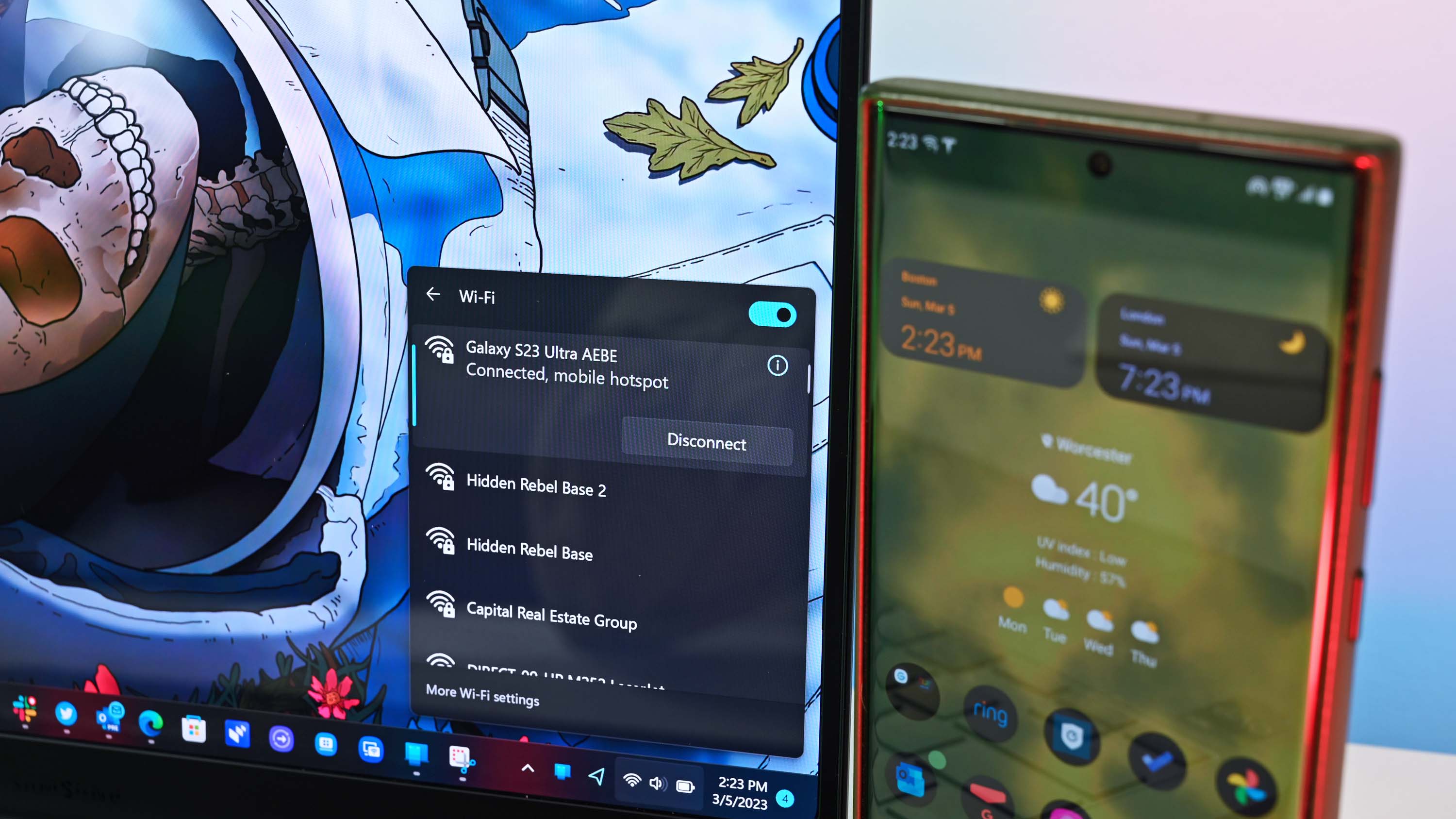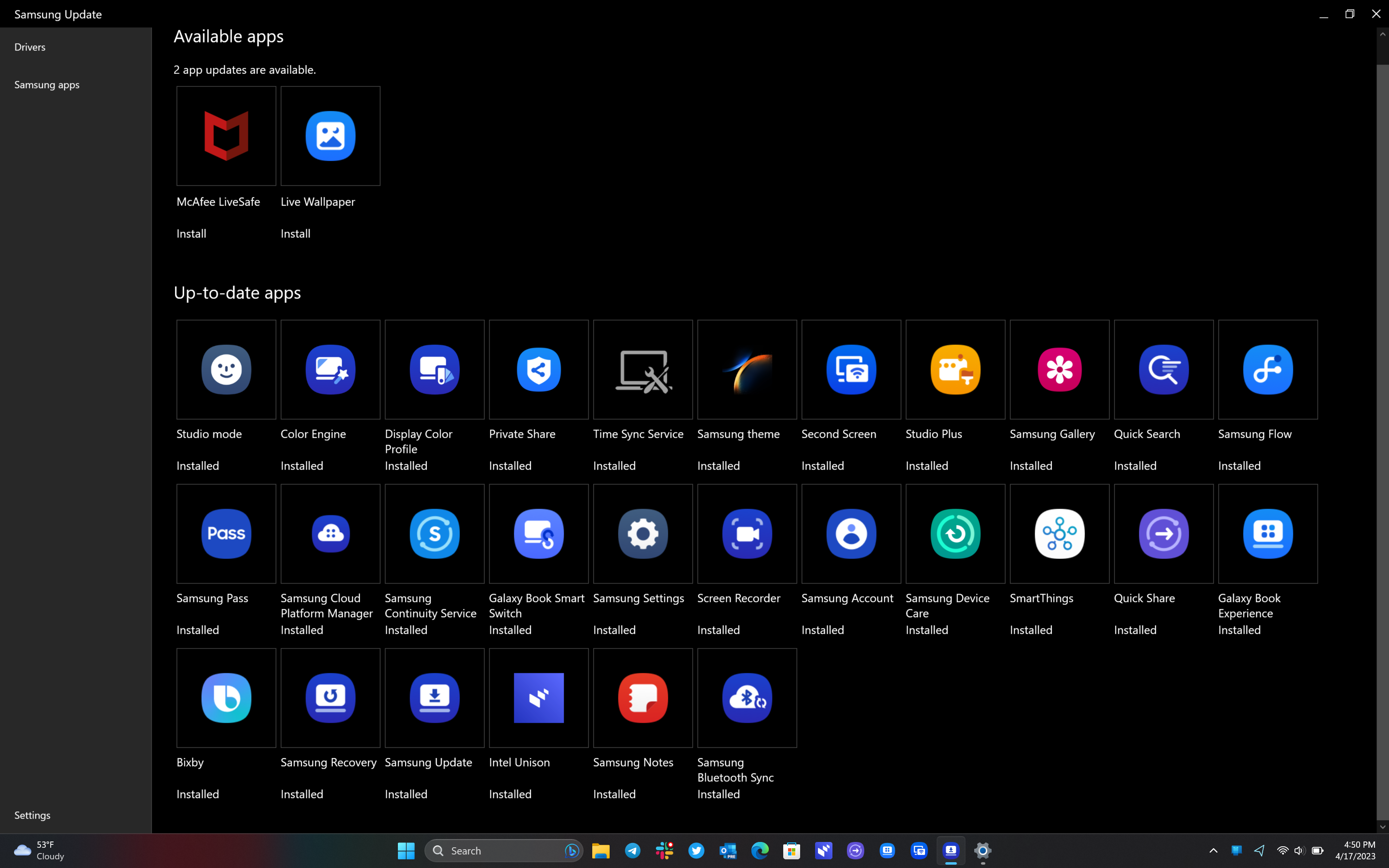Windows Central Verdict
Samsung has a winner on its hands with the refreshed Galaxy Book3 Pro (14-inch). It's thin and light with excellent build quality, and arguably has one of the best displays thanks to its premium 3K AMOLED screen. It's also more potent than you'd think with that Core i7, considering it's only 2.42 lbs. Generous trade-in offers from Samsung also make it a good deal.
Pros
- +
Very slim and light
- +
Powerful processor
- +
Amazing AMOLED display
- +
Quality design
- +
Galaxy phone tie-in
Cons
- -
Battery life is mediocre
- -
No Windows Hello face recognition
Why you can trust Windows Central
Samsung has been building laptops for many years now, but it has only been in the last few that the company has hit a stride (and a consistent naming scheme). I’d argue that trend started with the Galaxy Book2 series, which mainly delivered great hardware but with outdated design choices like a 16:9 full HD display.
With the Galaxy Book3 Pro, Samsung is coming into its own. Featuring a 3K AMOLED display — now with a preferable 16:10 aspect ratio — the latest Intel 13th Gen processor, and a very thin and sleek design... It pains me to say it makes Microsoft’s Surface Laptop 5 look dated.
What else did Samsung get right (and wrong)? And why should you consider this laptop for your personal use? I’ll answer those questions here as I've been using this laptop as my main PC for the last 4 weeks.
Disclaimer: This review was made possible by a review unit provided by Samsung. The company did not see the contents of the review before publishing.
Samsung Galaxy Book3 Pro: Pricing, specs, and availability
The Samsung Galaxy Book3 Pro is available directly from Samsung, Amazon, and Best Buy with a starting price of $1,450 for the 14-inch model and $1,550 for the 16-inch version.
Price: $1,449 (starting); $1,649 (reviewed at)
CPU: Intel Core i7-1360P
GPU: Iris Xe
RAM: 16GB
Storage: 1TB
Display: 14-inch, OLED 3K
Battery: 6:58
Size: 312.3 x 223.8 x 11.3mm
Weight: 2.42 lbs (1.17 kg)
It’s worth noting, however, that Samsung has a very generous trade-in program that accepts smartwatches, tablets, PCs, and phones. Those trade-ins can bring the price down by more than $500 depending on how new the item is (and likely a preference for Samsung’s hardware, similar to Apple's program). So, if you have a laptop or phone you want to give up, go directly with Samsung to get the most bang for your dollar.
There aren’t many configuration options as you only get a Core i7 processor, 16GB of RAM, and either 512GB or 1TB of storage (user upgradeable). There are also two color options, graphite or beige.
All the latest news, reviews, and guides for Windows and Xbox diehards.
The 16” model is the same as the 14” save for the larger display, but it also has a full number pad section, which is a valuable addition for many. The 14-inch does not have a number pad and is more traditional.
There is also a 16-inch “360” convertible model complete with an S Pen and a starting price of $1,699.
If you want even more power, Samsung has the all-new Galaxy Book3 Ultra. It’s a 16-inch laptop but packs an NVIDIA RTX 4050/4070 GPU and 13th Gen Intel H-series processor, making it a much more formidable device, but still with a slim body. It starts at $2,199, but is configurable up to $3,000 depending on GPU, RAM, and storage options.
For this review, Samsung sent us the most affordable Galaxy Book3 Pro, the 14-inch model with a Core i7, 16GB of RAM, and 512GB storage in the graphite colorway priced at $1,450.
Samsung Galaxy Book3 Pro Recommended Configuration
If you hate fingerprints, get the beige 14-inch version of the Samsung Galaxy Book3 Pro from Best Buy (for easy returns and in-store experience) with a Core i7, 16GB of RAM, and 512GB for the most bang for your buck. You can always upgrade the SSD later and save some money.
Samsung Galaxy Book3 Pro: Design and build quality
I won’t spend much time on design and quality simply because this is Samsung. Like its phones, the company knows how to build excellent premium-feeling hardware.
The Galaxy Book3 Pro is all metal but is comparatively light at 1.17kg (2.42 lbs) compared to other 14-inch laptops in this class. It’s also very thin at 11.3mm, which is even thinner than last year’s model at 11.9mm, although it is slightly heavier than 2022’s at 1.04kg (2.29 lbs).
It’s an immaculate and minimalist design with only Samsung’s logo in small print on the outer lid with its mirror finish.
Despite this laptop’s size, Samsung still squeezed in a full Type-A port, which is becoming increasingly rare, same with the microSD slot. There is also a full HDMI and two Type-C Thunderbolt 4 ports. Overall, that’s an exceptional selection considering some laptops only have a few Thunderbolt 4 ports. And yes, there is still a headphone/mic jack, too.

Opening the lid is easy thanks to the cut-out notch, and you can do it one-handed with ease.
Since the display is taller at 14” instead of 13.3”, Samsung could extend the keyboard deck and put in a much larger touchpad, which it did.
The graphite color, like a very dark blue/light black, looks great and is more traditional. However, if you dislike fingerprints, a better choice is the beige model, which will hide them better.
Giving the Galaxy Book3 Pro to friends to hold and use and they were all very impressed with the looks, feel, size, and weight. Indeed, Samsung did nail the looks and build quality here.
Samsung Galaxy Book3 Pro: Display
Samsung finally listened, well, I guess to me and others, by drastically improving its display for Book3 Pro. Sure, last year’s full HD AMOLED with a 16:9 still looked great, but the resolution felt on the low side for a premium laptop, and 16:9 is very 2019.
Now, the display is everything you’d want it to be: Dynamic AMOLED 2X (16:10 ratio), 400nits, 120Hz, 120% Color volume (DCI-P3), and “3K” resolution at 2880x1800.
Simply put, the display is gorgeous. Even the reflectivity is low, making it ideal for long working sessions. Like in previous years, Samsung’s color profile can auto-adapt to the content you’re viewing, or you can set it manually.
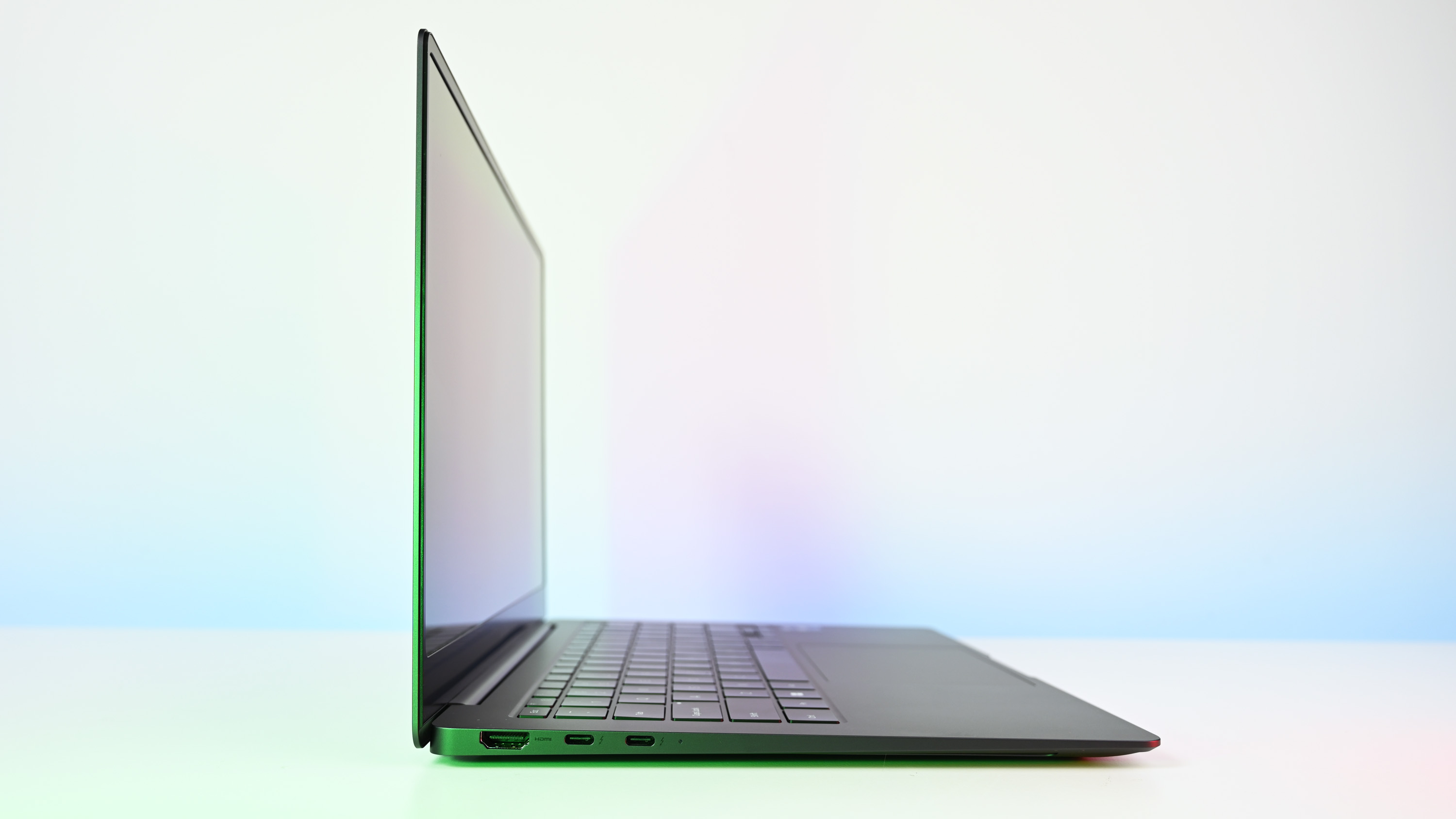
Color accuracy is outstanding as this AMOLED screen earned 100% sRGB, 97% AdobeRGB, and the rare 100% DCI-P3 making it ideal for photo editing, web work, or any creative task where a premium color gamut is required.
Brightness is tricky, but the tl;dr is it’s great on this laptop. The reason for the caveat is at 100%, this laptop “only” gets 395 nits of brightness. That’s not astounding these days, but the AMOLED technology makes the screen appear brighter and more contrasty than a standard LCD. Conversely, when set to 0%, the display gets just 3.8 nits making it ideal for working at night in dark rooms without blinding you.
The bottom line: This is one of the best non-touch screens you’ll find on a Windows PC without reservation. You’d expect nothing less from Samsung, and it delivers.
Samsung Galaxy Book3 Pro: Performance

Considering how thin and light the Galaxy Book3 Pro is, the rule of thumb has been you sacrifice performance (and battery life) to achieve those ends. But that’s not the story here at all.
The Galaxy Book 3 Pro has an impressive 13th Gen Intel Core i7-1360P processor. The P-series here features 12 cores (16 threads), 28W power draw, and can peak at 5.0 GHz. When I first heard of the Book3 Pro, I assumed it’d feature the Intel U-series, which while still performant, draws less power, has fewer cores and has less overall speed. U-series is made for this laptop, whereas the P-series is a bold move delivering some serious CPU cycles.
On PCMark 10, the Galaxy Book3 Pro scores 5,781, which even beats out AMD’s latest Ryzen 7 7736U (HP Dragonfly Pro) at 5,637. To put it in perspective, this Galaxy Book3 Pro trounces the HP Pavilion Plus 14 (2022), which has a 45W Core i7-12700H series processor (5,530). It even beats out Dell’s highly touted XPS 13 Plus (late 2022), with only a 4,739 score.
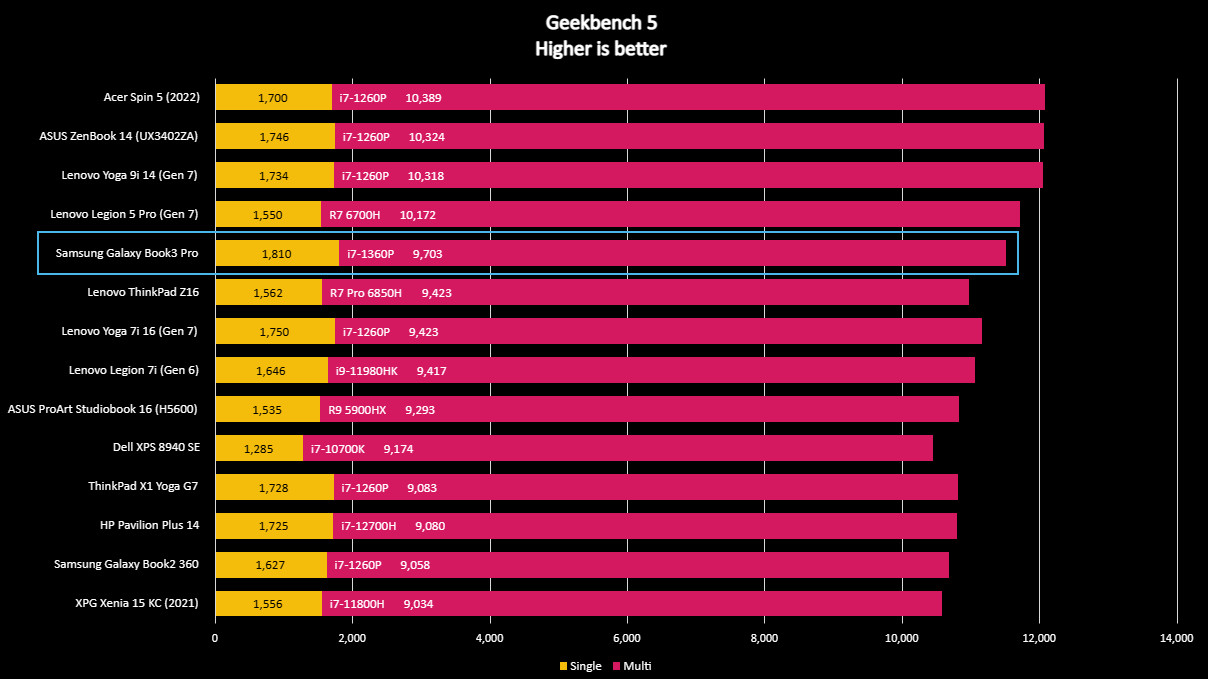
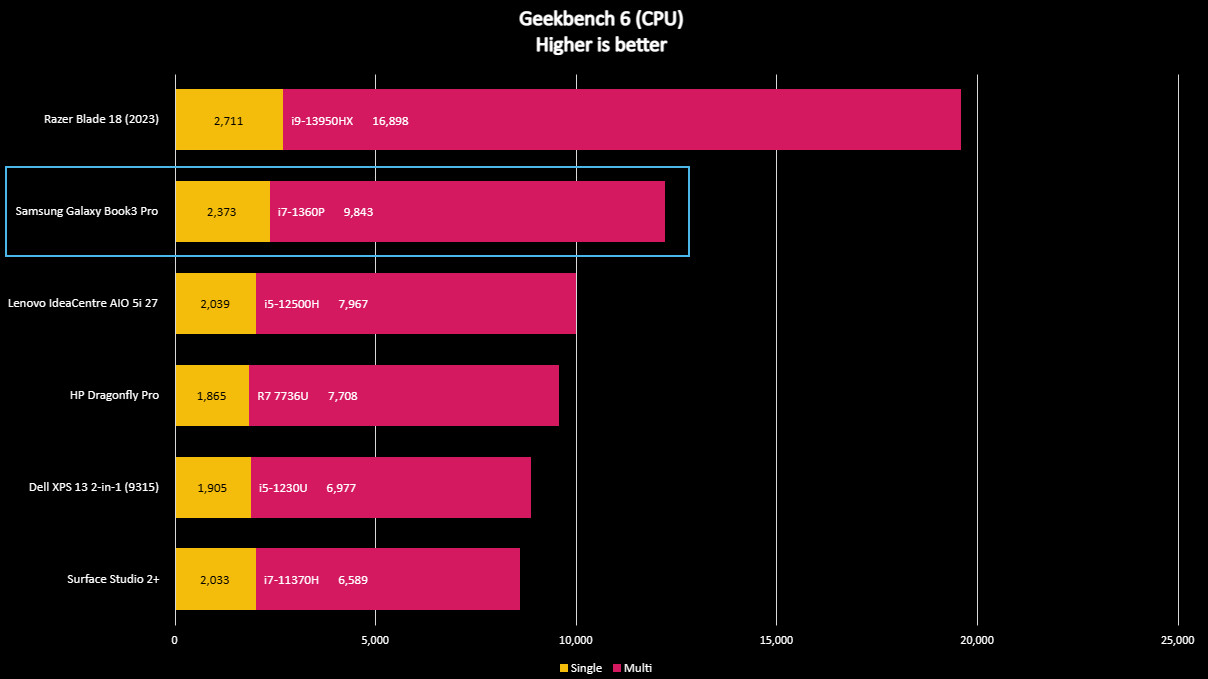

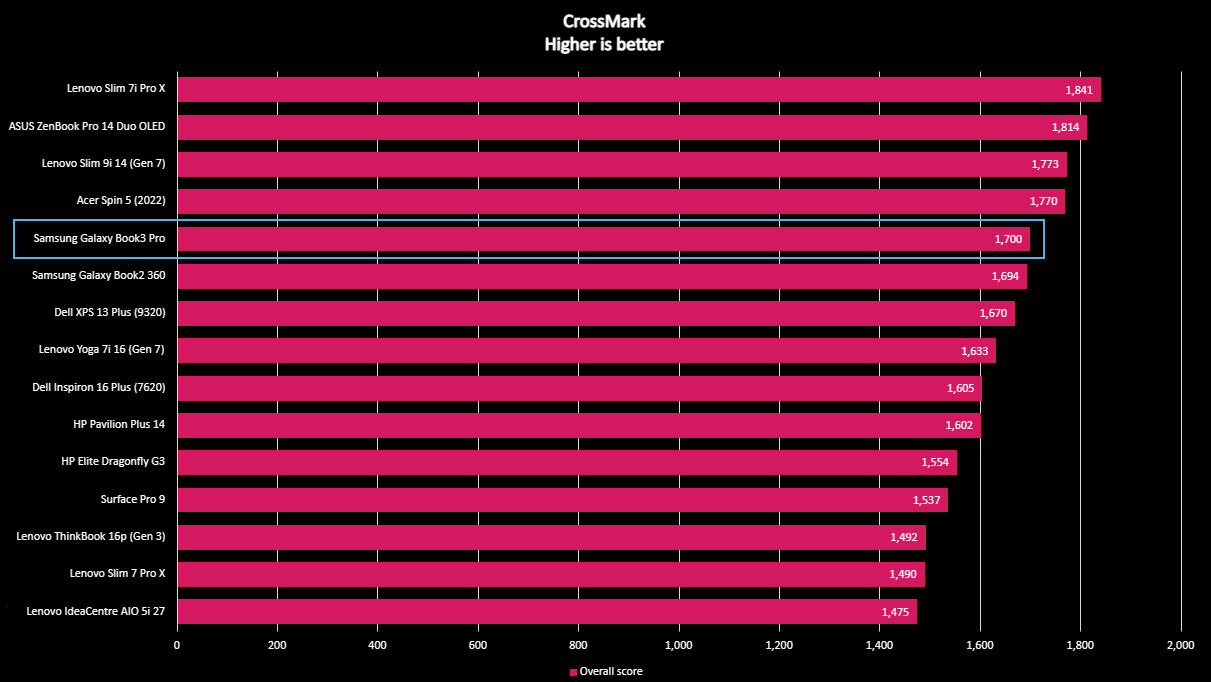
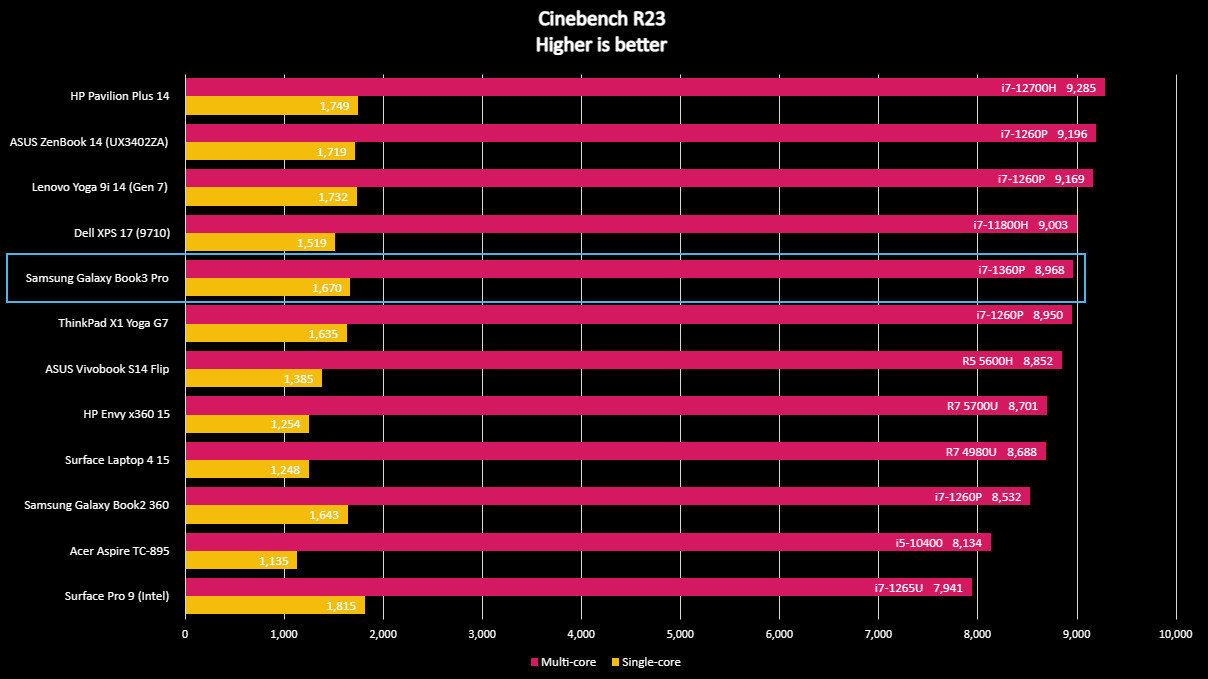
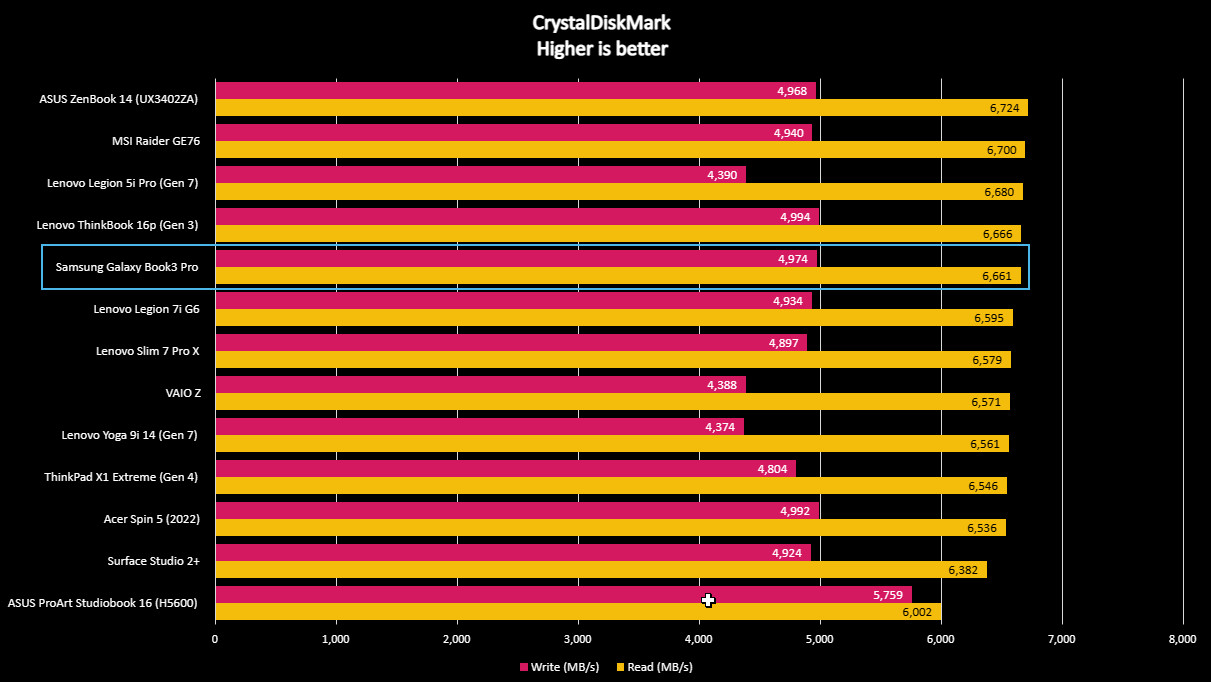
Turning to Geekbench 5, which focuses on CPU performance specifically, the Galaxy Book3 Pro gets one of the highest single-core scores I’ve seen in this laptop class (i.e., not a gaming laptop) with 1,810. Same with the multi-core, which scored an impressive 9,703. Again, this CPU can beat out a 12th gen H-series processor (1,714 and 8,976) for comparison.
For the SSD, Samsung doesn’t cut corners as, after all, it makes its own. The 1TB SSD pulls in 6,661 MB/s for sequential read and 4,974 MB/s for write, which puts it up near premium 2023 laptops using PCIe 4.0.
Fan noise is surprisingly low, although audible when using Performance mode, which is expected as that gives the most CPU output while keeping the laptop cool. But Samsung does offer its own performance profiles (more on that below), which means you can set it to Quiet (very low fan usage) or even Silent, where the Galaxy Book3 Pro runs with no fans. It’s an intriguing and unique option that only Samsung is currently offering.
Samsung Galaxy Book3 Pro: Battery life
Battery life is better than expected, considering the chassis design, thinness, and how light it is compared to other laptops in this category. However, that doesn’t mean it’s outstanding, either, as between the powerful processor, 3K AMOLED display, and battery size, the Galaxy Book3 Pro won’t be an endurance champion.
In my real-world experience and relying on the Windows Battery Report, I averaged around 6 to 7 hours of screen time. That includes heavy web browsing, messaging (Telegram, Slack), watching videos on YouTube, using Microsoft Office, and other “knowledge workers” tasks.
Turning to synthetic benchmarks using PCMark 10 Modern Office, which loops through video calls, web browsing, photo editing, document editing, and more with pauses to simulate actual workflow, the Galaxy Book3 Pro yields just shy of 7 hours with 50% display brightness. (The test ran using Optimized mode for performance, which is the default, and the display auto-brightness was disabled).
Samsung Galaxy Book3 Pro: Keyboard and touchpad
Typing is better than expected with the Galaxy Book3 Pro, even with the lower-travel and chicklet key design. I found typing to be effortless and didn’t require much exertion with high accuracy. As a result, I’d rank the typing experience as very high and satisfying.
The keys pick up ‘shine’ after days of typing away, but that’s not unusual. Backlighting is sharp as a tack, well lit, with no light bleed anywhere, and looks great in any lighting conditions. It is multi-stage and controlled via the dedicated F9 function key. Users can set it at 0, 30, 60, or 100%, and Samsung has a nice on-screen message box letting you know your current level, taking out the guesswork.
Speaking of function keys, Samsung has ones dedicated to the Samsung Settings app, display brightness, keyboard brightness, volume, locking both camera and microphone, and switching performance profiles between Silent, Quiet, Optimized, and High Performance. Again, a small message box appears on-screen to let you know where you are at. Of course, setting the laptop to Silent or Quiet does reduce performance slightly (and the computer could get warmer due to no- or low-running fans). Still, with this P-series chip, if doing regular web and office work, it’s often preferable to have that quietness.
A fingerprint reader resides in the power button, which works very well for logging into the laptop. Unfortunately, for whatever reason, Samsung never uses Windows Hello face recognition in its laptops, which is a slight letdown but shouldn’t be a dealbreaker. My educated engineering guess is this display is simply too thin to house the infrared sensor.
The touchpad is enormous and enjoyable to use. It’s smooth, accurate, and has an excellent click. That said, Samsung should lean into a haptic touchpad next time to save space, be more reliable, and be user-configurable.
Samsung Galaxy Book3 Pro: Camera and audio
Samsung has a lot of experience doing audio on mobile devices, so it’s not surprising that the audio profile in this laptop is quite good. Samsung packs a lot into this chassis with four AKG speakers (two 5W subwoofers and two 2W tweeters with Smart Amp) and Dolby Atmos software for adding spatial abilities. I tend to watch videos with dialogue as the principal use, and Dolby Atmos does a fantastic job of centering voice while keeping other music/background noise to the virtual sides.
The front-facing full HD (1080P) 2.1 MP camera is the smaller size (compared to HP’s 5MP ones), but it does OK for the color and overall appearance, although a higher megapixel count would have made it sharper.
To spice things up, Samsung includes “Studio mode,” a free-floating toolbar that appears whenever you use the camera in any Windows app. Face effects (smoothing), background effects (solid color, blur, custom image), auto-framing, HDR, and even eye contact are included. The latter uses AI to simulate constant eye contact with the camera. The whole package works quite well and is fun to use.
Samsung Galaxy Book3 Pro: Software and phone
Samsung packs a LOT of software into its laptops, which is a good thing, especially if you have a Samsung Galaxy phone to pair with.
For this review, I used the Samsung Galaxy S23 Ultra (loaned by Samsung), which, while expensive, is not only the best Galaxy phone I have used but also the best Android one. The phone’s battery life is incredibly good (I often finished the day with 75% remaining), the cameras are excellent, and the newer flatter design with siloed S Pen is perfection.
One new feature this year works with Microsoft’s Phone Link, which lets your Samsung phone show up under Wi-Fi settings for one-touch hot-spot access. It’s a clever integration that makes getting the Galaxy Book3 Pro online much easier and faster.
Apps for the Galaxy Book3 Pro include Samsung Flow, Gallery, Notes, Pass, Recover, Settings, Studio Plus, TV Plus, Update, Second Screen, Private Share, Quick Search, Quick Share, SmartThings, and even its own custom screen recorder software. It’s all very neat and beneficial. Samsung Flow, for instance, lets you access and cast your phone to your laptop using either Bluetooth or Wi-Fi/LAN (with the latter being nearly lag-free). You can see and act on notifications and run your phone directly from the laptop (the phone’s display, however, must remain on). Samsung Gallery mirrors your Samsung phone’s photo gallery (via OneDrive).
The Live Wallpaper app is a bit heavy and slow, but it does let you pick some interesting backgrounds, including ones that adjust to the current time.
Many of the included apps are the same ones found on Samsung Galaxy phones, making them all very familiar if you have one. The apps are well-written and look to be 1:1 clones but tailored for Windows.
Some of these features overlap with Microsoft’s Phone Link and Intel Unison, which are included and pre-installed. At least users have a choice, with all three being good options.
There are so many Samsung apps it can be overwhelming, and you may never touch many of them. And that’s the upside, as all these apps are un-installable and can be reaccessed via the Samsung Update app, which houses all of them in case you need to re-download any later (that includes McAfee LiveSafe, which, unfortunately, is pre-installed).
Samsung Galaxy Book3 Pro: Competition
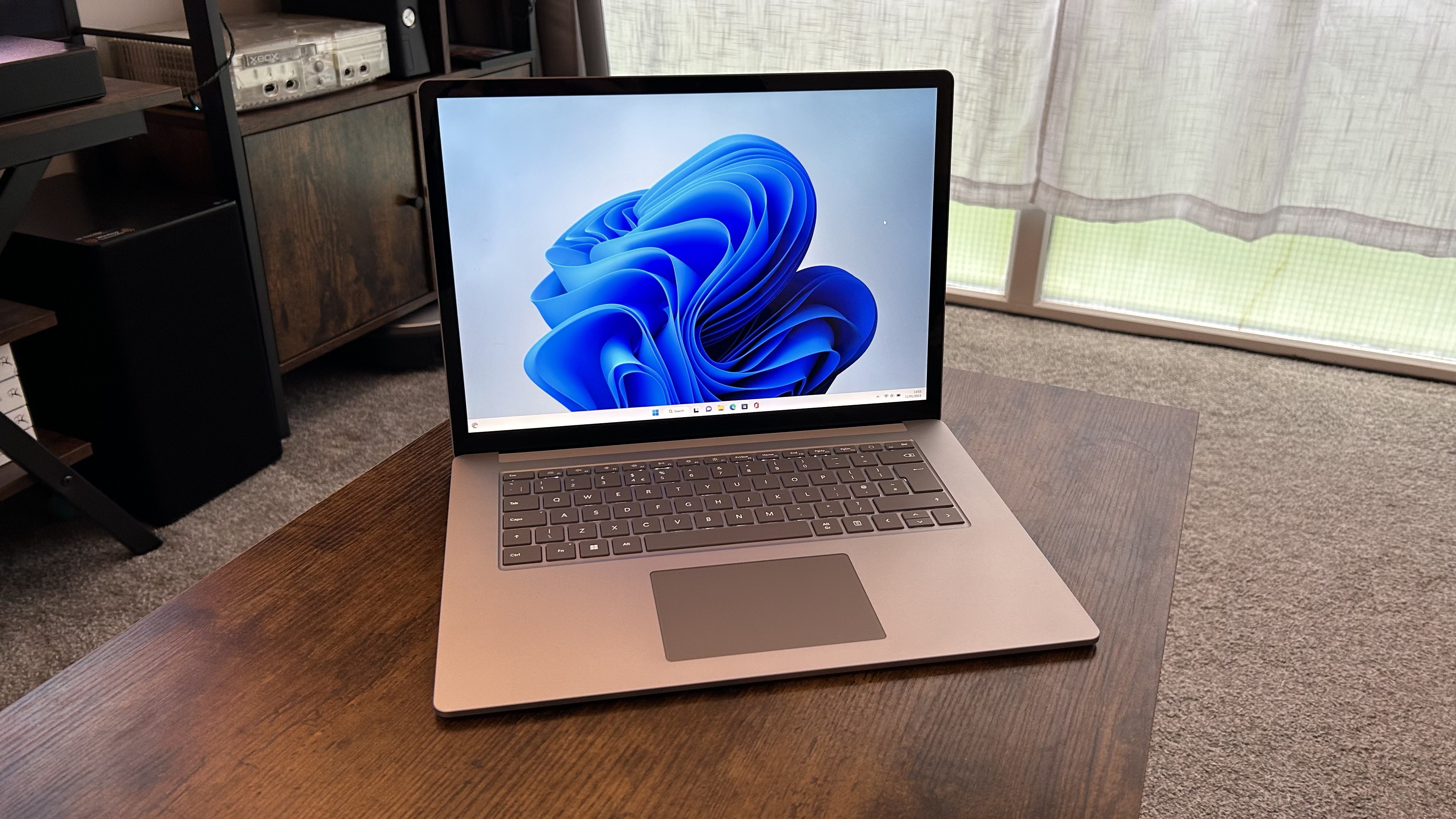
There are a lot of 14-inch alternatives on the market today, many of which are excellent choices. However, none are as thin and premium as Samsung’s offering, which stands on its own.
The Lenovo Slim 9i 14 (Gen 7) is an excellent laptop with an OLED display, 12th Gen Intel Core i7-1280P processor, and plenty of RAM and storage, but heavier at 3.02 pounds (1.37kg) and about a millimeter thicker. It also lacks variety for ports with only three Type-C (Thunderbolt 4) instead of full HDMI, Type-C, and USB Type-A like the Galaxy Book3 Pro.
Microsoft's Surface Laptop 5 comes closest in terms of quality and overall experience. Microsoft’s vision is much more minimalist, with few added apps or custom software. It’s a dated design, but the core fundamentals (keyboard, audio, display, webcam, and quality) are near the top. However, you only get one Type-C (Thunderbolt 4), one Type-A, and Surface Connect for ports, although the weight is quite good at 2.8 lbs (1.3kg).
HP Spectre x360 13.5 also falls nicely into this category. While it will be heavier, it is a 2-in-1 with a touch screen, included pen, and a very impressive display. In addition, it has a knock-out keyboard, an excellent front-facing camera, and it is one of the more elegant laptop options anyone should consider.
While more challenging to find, the LG Gram 14 is also extremely light at just 2.2 lbs (999g). It has an Intel 12th Gen P-series processor, plenty of RAM and storage options, but only a full HD (1920 x 1200) non-touch display.
See our other best Windows 11 laptops for more ideas.
Samsung Galaxy Book3 Pro: Should you buy it?
You should buy this if …
- You value a thin and light design.
- You want one of the best AMOLED displays.
- You want solid performance from a trusted brand.
- You already have a Galaxy phone and/or tablet.
You should not buy this if …
- You want 4G LTE/5G connectivity.
- You need a touch display or pen support.
- You need something with a discrete NVIDIA GPU.
Despite being a major electronics brand, I sometimes think Samsung is underappreciated by many in the laptop space. But the company has been making laptops for years, and they’ve always been elegant, high quality, and often unique. That said, Samsung is often a generation behind where everyone else is like sticking with 16:9, low-resolution displays for far too long.
However, I’d argue that the new Galaxy Book3 Pro 14-inch is the culmination of what Samsung has learned over the years. The 16:10 AMOLED display is now much higher resolution and is simply tantalizing. Sure, it lacks touch, but the display panel is thin, and the laptop is lighter due to that choice.
Basically, Samsung has addressed all my earlier complaints from previous generations.
Performance is also fantastic, and the ability to run it silently with no fans or quiet is an excellent option if you’re sticking to basic productivity tasks. The keyboard, touchpad, audio, and the full Samsung software suite are compelling. This laptop is an extension of Samsung’s latest Galaxy phones, making them a natural pair and a great value add for loyal Samsung customers.
Battery life is not amazingly good, but much of that is still due to Intel’s big.LITTLE design, which, while extremely powerful, is not entirely optimized for battery life. That said, I found the experience adequate for daily work (and the included Samsung Fast Charge is welcomed for quickly topping it off).
Given a choice between this laptop and Surface Laptop 5, I don’t even think it’s close. Samsung wins in nearly every category, making it one of the best premium ultra-thin and light Windows laptops with a fantastic display. It’s a knockout.

Daniel Rubino is the Editor-in-chief of Windows Central. He is also the head reviewer, podcast co-host, and analyst. He has been covering Microsoft since 2007 when this site was called WMExperts (and later Windows Phone Central). His interests include Windows, laptops, next-gen computing, and wearable tech. He has reviewed laptops for over 10 years and is particularly fond of 2-in-1 convertibles, Arm64 processors, new form factors, and thin-and-light PCs. Before all this tech stuff, he worked on a Ph.D. in linguistics, performed polysomnographs in NYC, and was a motion-picture operator for 17 years.
